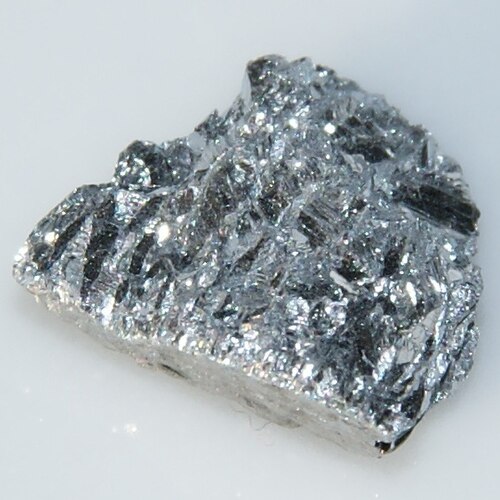Facts for Kids
Antimony is a brittle, silvery-white metalloid that is used in a variety of industrial applications, including flame retardants and lead alloys.
Overview
Uses Of Antimony
Antimony Compounds
Antimony In Nature
History Of Antimony
Antimony In Technology
Properties Of Antimony
Extraction And Processing
Health And Environmental Impact

Inside this Article
Melting Point
Earth's Crust
Robert Boyle
Electronics
Government
Production
Morocco
Mineral
Silver
Did you know?
🔬 Antimony is a metalloid with the symbol Sb and atomic number 51.
⚗️ It has been used since ancient times in cosmetics and medicine.
⚒️ Antimony is primarily extracted from the mineral stibnite (Sb2S3).
🧪 The element is known for its ability to form complex compounds with halogens.
🌡️ Antimony has a melting point of 630.6 °C (1,167.1 °F).
💡 It is used in flame retardants and lead-acid batteries.
🔋 Antimony enhances the mechanical properties of lead alloys.
🧵 The material is used in the production of various types of glass.
📅 Antimony is listed as a priority substance by many environmental protection agencies.
🏭 The global market for antimony products is significant, mainly driven by industrial applications.
Introduction
Antimony has been used by people for thousands of years. Its name comes from the Greek word "anti-monos," meaning "not alone," because it rarely exists by itself. You can find antimony in places like China, which produces about 90% of the world's antimony! Its unique properties make it very useful in many industries. Let's dive in and learn more about this interesting element! ⚙
️
Uses Of Antimony
Antimony compounds are also used in batteries, especially in lead-acid batteries found in cars! Furthermore, this metal is used in glass production, giving it a brilliant shine. 🎨
Antimony is also included in some types of alloys, which are mixtures of different metals, to improve their strength. Additionally, antimony is found in some cosmetics, like eye shadows, making them sparkle! 💁
♀️✨
Antimony Compounds
Another compound, antimony sulfide, is found in some fireworks, helping to create bright colors. 🎆
Antimonophyllitis, a rare mineral, is another interesting compound that can be found in old mines. Scientists continue to study antimony compounds to discover new uses and understand their properties better. 🧪✨
Antimony In Nature
Antimony can also appear in very small amounts in water and soil. Some plants, like certain ferns, have learned to absorb antimony from the ground. However, antimony is rare, making up only about 0.2 parts per million in the Earth's crust. 🌱
Discovering antimony in nature is exciting because it helps scientists understand our planet better! 🔍
History Of Antimony
️💄 It was also used in Ancient Rome and Greece. The famous scientist Robert Boyle studied antimony in the 17th century and discovered new information about it. The modern way to extract antimony began in the 1800s when scientists learned how to pull it out from its ores. Today, we continue to learn more about this remarkable metal! 🏺📚
Antimony In Technology
It is used in batteries to help power gadgets like smartphones and laptops, making them last longer. Antimony also enhances the strength of alloys used in electronics, helping devices work better. 🎮
Some researchers are studying antimony to create new materials for future technologies! With its unique properties, antimony is paving the way for advancements not just in tech, but in areas like renewable energy. 🚀
Antimony is a little element, but it has a big future!
Properties Of Antimony
It has a melting point of 630.6 degrees Celsius (1,167 degrees Fahrenheit) and boils at 1,585 degrees Celsius (2,885 degrees Fahrenheit). Antimony doesn't conduct electricity as well as metals but can still conduct some. Its crystal structure is very special—it forms beautiful, shiny crystals! When you heat antimony, it can change from a solid to a liquid, but many of its amazing characteristics stay the same. 🧊✨
Extraction And Processing
️ The most common ore, stibnite, is then heated in a furnace to separate antimony from the other materials. This process is called smelting. As antimony melts, it is collected and cooled to create solid metal again. 🌡
️ After extraction, antimony is processed to make it suitable for use in various products. Scientists are always looking for better ways to extract and recycle antimony safely for our world! 🌍💡
Health And Environmental Impact
When humans are exposed to high levels of antimony, it can cause health problems, such as skin irritation or breathing issues. The government regulates how much antimony can be in the environment to keep us safe. 💧
It's crucial to dispose of antimony products properly, so they don’t harm nature. When used responsibly, antimony can be safe; however, it's always best to handle it with care to protect both people and the planet! 🌎❤️

